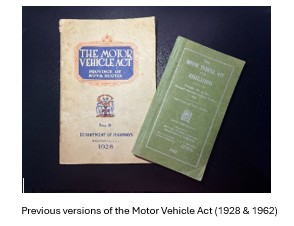By Mike Christian, Director of Traffic Safety Act (TSA) Implementation, RMV Modernization
The Registry of Motor Vehicles has been working towards modernizing traffic safety legislation in Nova Scotia. Our aim is to make sure that it meets the needs of citizens and Government almost 100 years after it was first introduced.
The Motor Vehicle Act (MVA) is legislation that establishes the requirements for all road users in Nova Scotia. It was put in place in the early 1900s and – although Government has approved numerous amendments since then – the Act hasn’t been rewritten since the 1930s. This means parts of the legislation are:
- outdated – for example, there’s a section on streetcars even though the final streetcar journey in Nova Scotia took place in 1949.
- inconsistent – over the years, small amendments in one part of the Act have created inconsistencies in others. For example, the definition of a commercial vehicle is different in 4 regulations. That’s confusing for citizens and stakeholders too.
- unclear – for example, the legislation around using hand-held devices is ambiguous which makes it difficult for citizens to know what’s permitted and for law enforcement to enforce the law.

Why is CSDS talking about updating the rules of the road?
It’s part of our modernization efforts, which aim to update and improve our systems, policies, and processes to better serve Nova Scotians. By including policy changes, we can suggest updates based on what users need. We’re planning how to implement products and services that match these changes, ensuring they are efficient, user-friendly, and aligned with current technologies and needs.
More responsive legislation
The TSA, first tabled in 2018, is intended to replace the Motor Vehicle Act, updating old rules and language while also providing a flexible legislative framework.
As part of our efforts to modernize, we have consolidated the MVA’s 96 regulations by:
- grouping similar ones and combining them
- getting rid of duplication or outdated ones
The new Traffic Safety Act (TSA) has 26 regulations (67 fewer than the MVA). The new, more concise structure means it will be easier for citizens to find and understand the rules and requirements should they need to.
The improved flexibility of the framework also means we’ll be able to amend legislation and regulations more quickly and with less effort when we need to. We can already see several examples of where we’ll need to do this, including the eventual arrival of self-driving cars and driverless delivery vehicles.
Agreeing on a new approach
Although the TSA was passed (which means Government agreed to the change), it was not proclaimed (i.e., it did not become law) so the MVA is still in effect.
In 2021, the TSA went through a review process for implementation.
We quickly realized that the number and scale of changes would pose implementation challenges and have a huge impact on Nova Scotians. In November of 2023, government agreed on a phased implementation approach for the TSA.
Where we’re at and where we’re going
We have finished redrafting the TSA and its regulations. The new version of the TSA includes several road safety improvements. To manage the change and impact, several other aspects have been brought to match the MVA for now.
Before the TSA can be proclaimed, there is work that we must complete. We’ve developed an implementation plan, which is already underway:
- updating web content, forms, and policies
- educating law enforcement and other RMV partners on the new legislation
- updating content such as the Driver Handbook and knowledge tests
- updating services and internal facing systems
We will continue to provide updates on our progress. Our next blog post will talk more about the TSA, our decision to redraft and what to expect going forward.
